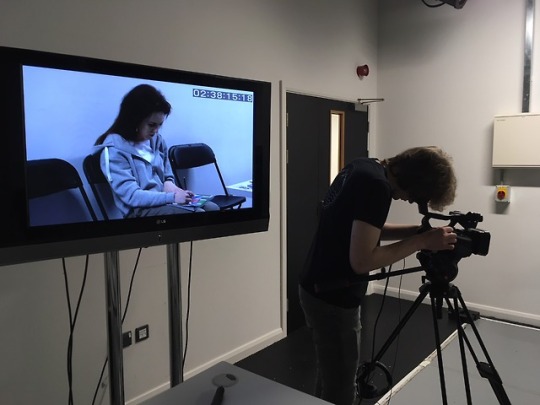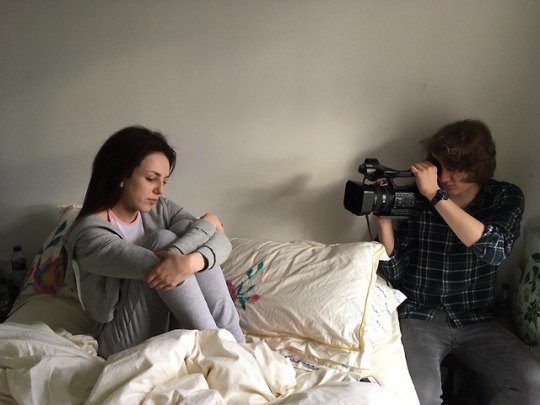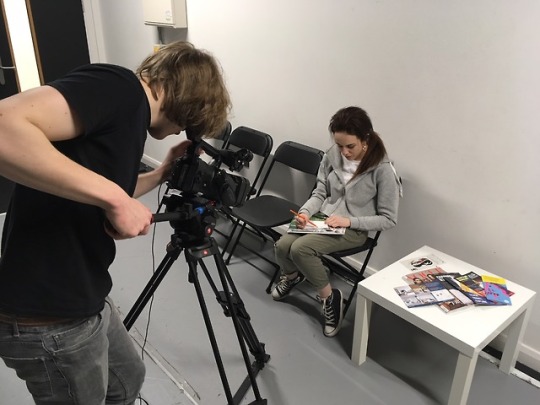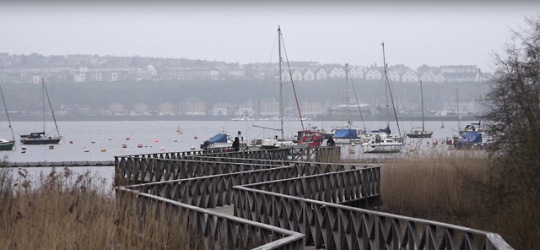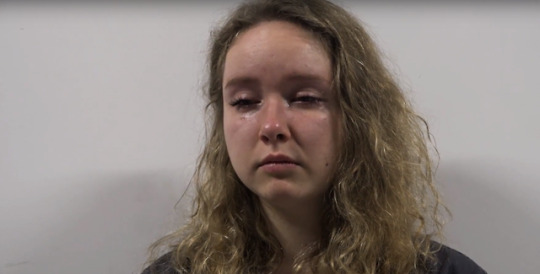Text
Welcome
Two Minds (2018) is a student short film tackling the issue of abortion in contemporary society.
Written and directed by Hannah Moreno and Olivija Arlauskaite.
You may find the film here and the bibliography here
0 notes
Text
Screening and Feedback
After presenting our film to the class, we got some great feedback, from our peers, we will quote their comments:-
“ I felt it was made to make me feel uncomfortable but at the same time drew me in, I loved the concept of the slow cinema, it fitted the style perfectly.” -Tom Dyer
“I wasn’t expecting the voices at the end, it was great because you don’t always need dialogue throughout a film or performance to make the story apparent.” -Gwen James
“ I was surprised at the silence with strong feeling in the film and the impact it had on such a delicate subject, the character transitions displayed their unison, even though they had individual thoughts and feelings.” - Gabby Dunn
This module Performance and Gender is a new subject and very current to the outside world. We have learnt so much about the type casting of individuals and how to stay away from stereotypes; for example the endless possibilities of different roles performed by different genders. It’s broadened our outlook on future roles that we could play, which gave us more enthusiasm to experiment.
0 notes
Text
Rehearsal Process
Our rehearsal started with the discussion of various ideas for our performance.
We had the option to either create a film lasting approximately seven minutes or to devise a fifteen minute live performance. Olivija suggested basing our subject on abortion as it is a current global issue. One of the most important issues in biomedical ethics is the controversy surrounding abortion. This controversy has a long history and is still heavily discussed among researchers and the public, both in terms of morality and in terms of legality.
(Gordon, n.d.)
Our initial idea was to create a live performance giving the audience a feeling of apprehension and slight discomfort which is a more effective way to demonstrate similar to ‘In Yer-Face Theatre’. After further research into abortions, we realized it would be a better artistic choice to create a film, as editing a film allows more control over our transitions compared to a live performance, for example, with films, a scene can be changed instantly due to the fact that our style was abstract, therefore, we had more scope to adapt to the overall performance.
We focused our attention on two girls, played by Hannah Moreno and Olivija Arlauskaite, which influenced our film title ‘Two Minds’. We wanted to make a point of being in opposing minds regarding this situation. Originally, our idea was to create a clash between the two characters, causing emotional conflict with each other’s decisions. Filming the individuality of the girls was our final choice as it represented isolation and solitude on their complex entwined journey
Our first location was in Cardiff Bay, in Hannah’s flat, specifically using the bedroom. No dialogue was used as our producer Jack Holtom introduced us to slow cinema. For this reason, we felt that interactions with each other would change the dynamics of our film.
Our next location was set in the Atrium, using an empty classroom to resemble a clinic. We set it out as a waiting room, using only chairs and one table providing magazines.
Half way through this scene, the second character was introduced. Â We felt the need to do this through a transition, with one girl walking out of the room whilst the other is walking in. Olivija notices the doodle left behind, from this moment the camera zooms into her face, capturing a very sad moment of realization- both girls shared a connection supporting the Irish Referendum in legalizing abortions, which links the two girls for the first time.
For our last scene we needed a peaceful location to represent the ideal place- the girls would feel at ease and stress-free, enabling them to inhale the serenity of the quiet nature. We drove around the Cardiff Bay/Penarth area and found the perfect spot - the scenery of the Bay overlooking the Marina was a suitable place.
We knew we wanted a peaceful area near the water, surrounded by nature. We found exactly that, including a long zig zag bridge, which gave us an idea, to film the girls individually walking across the bridge. The reason for using the bridge/path was to show the complications the girls are going through. Despite both girls walking alone, they are in this together, the end of the pathway represents light at the end of the tunnel. Also, the last long shot signifies the next chapter.
During the editing, we realized the last scene took longer than planned. Even with background music we felt something was missing. Although, we originally agreed to have a silent film - one suggestion was to use voice overs whilst the girls walked across the bridge. By including dialogue it would answer any questions or queries the audience might have expecting a silent film with a slight twist at the end
Script - Voice Overs
Olivija - They told me I’m brave.
Hannah - But I am brave!
Olivija - How am I brave through? Women who give birth and raise their children are brave, not me.
Hannah - Yes, but this life is not for me, I’m not ready, I did the right thing.
Olivija - How am I supposed to know if I did the right thing?
Hannah - Just stop it!
Olivija - Stop what?
Hannah - Stop whining it’s already happened. I can’t change anything. Get on with it!
Olivija - why am I so selfish?
Hannah - I’m selfish because I have no choice and why the hell is it not ok to be selfish for once? I don’t want to fool myself and pretend that’s what I want.
Olivija - Am I fooling myself?
Hannah - Yes just stop it! I am not ready.
Olivija - No, I’m not ready.
Hannah - We did the right thing.
Equipment
Sony Nx100 Camera (1080p HD Quality) Manfrotto Tripod, Rode directional microphone with boom. Edited on an Apple Mac with Adobe PremierPro.
Roles and responsibilities:
Hannah Moreno - actor/director
Olivija Arlauskaite - actor/director
Jack Holtom - producer
Vita Arcimovica - assistant editor
Music Credit - Ross Bugden:
Track 1 - Reverie
Track 2 - Skies
See Bibliography post for full references.
0 notes
Text
Symbolism
The Flat - Bedroom Scene
-First scene is slow and at times still to represent the characters emotion- Isolation.
-The audience can see that the character becomes lifeless.
-We felt the need to change the set, move things around; however, we decided to leave the bedroom as it was - to represent a real situation, as the character would not have time to focus on her daily duties.
-The character ignores the phone call, she isolates herself from everyone. She does not want to be seen or heard, which gave us an idea to remain distant with the camera. Being invisible is her only desire.
- The keychain represents the character. She is bright, open-minded, she believes in people’s rights. She loves travelling. However, her feelings are currently locked.
-The character is researching the Irish Referendum- it shows that she is interested not only in herself but what is happening in the world. She is looking for a relief; nevertheless it’s a first clue for the audience.
The Clinic Scene
-The character is shown coloring in the Irish flag- It represents her support towards the legalization of abortions in Ireland, also it is something that makes her feel better about herself and her decision.
-Doctor is a male, reason for this is to distance ourselves from stereotypes, that males do not support abortions and want to be in control of women’s bodies.
-The character gets led to the consultation room. The audience cannot see what happens as it’s confidential like it would be in real life.
-The new character is introduced for the first time, she is going through the same thing- An abortion, and the reason behind this transition is to show that these two girls are going through the same thing but dealing with it differently.
-The new character sits down and notices the doodle (Irish Flag), left behind from the other character, from this moment you can see the connection between the two girls.
- We decided to do a long shot of the character crying, to make it apparent that she went through with the abortion.
-Both characters share similarities, however, they have different emotions and deal with an abortion differently.
The Zig-Zag Path Scene
-Life is like a zig Zag, there is no such thing as a straight path. The reason we are using the bridge/path is to show the complication the characters are going through. It represents their emotions; overthinking...
-Despite the fact that both characters are walking alone, they are in this together. They can support each other, the end of the pathway, is meant to represent light at the end of the tunnel- Hope.
-The last long shot represents the next chapter - it’s calm/peaceful.
0 notes
Text
Style
Our style was influenced by the slow cinema movement, that our producer introduced us to. We were shown many works of a Hungarian director Bela Tarr, but we decided to look for other slow cinema directors in order to help us understand the theory behind it before we directed the film. We found out about a Greek director Theo Angelopoulos, who writes that:
“Working with long takes was not a logical decision. I have always thought it was a natural choice. A need to incorporate natural time in space, as unity of space and time. A need for the so-called "dead time" between action and the expectation of action, which is usually eliminated by the editor's scissors, to function musically, like pauses. […] A fascinating and dangerous choice, which continues to the present day.” (Angelopoulos, 2009, p. 9)
We applied Angelopoulos’ ideas to our film in order to give a sense of time and duration, something that women who are going through abortion procedures experience, due to the slow nature of the processes, for example; when waiting between appointments. Additionally, as explained in a previous post, women often experience psychological trauma and mental health problems after having an abortion. We felt that the best way to show that the characters are struggling within their own minds was to allow the cinematic ‘dead time’ that Angelopoulos describes to take over certain moments of the story, elongating the crying shot that the audience may find uncomfortable. By staying in a lengthy close-up, we hoped to create the sense that a woman’s personal space and thoughts are being invaded by the camera, more conceptually, being invaded by the abortion treatment and the pressures that come with it.
We used Jonathan Romney’s observations to help us justify our “dangerous choice” (Angelopoulos, 2009, p. 9)to use long takes;
“The last decade certainly saw an increasing demand among cinéphiles for films that are slow, poetic, contemplative - cinema that downplays event in favour of mood, evocativeness and an intensified sense of temporality. Such films highlight the viewing process itself as a real-time experience in which, ideally, you become acutely aware of every minute, every second spent watching.” (Romney, 2010)
Despite our big ambitions, we knew that we were screening for an audience mainly made up of theatre students, therefore we acknowledged that there would probably be very little demand for slow films, especially amongst a young audience within the fast-paced atmosphere of a university. Nevertheless, we decided that we should make a point of playing against their expectations of a student film, deliberately slowing the pace, minimalizing the dialogue and favouring -as Romney writes- the mood, evocativeness and sense of temporality. (Romney, 2010)
See Bibliography post for full references.
0 notes
Text
Film Philosophy
Two Minds(2018) aims to support and give a voice to women who make a choice to have an abortion. We believe that every woman should be in control of her own body and decisions, therefore we decided to include the Irish referendum, as it represents a major obstacle -and taboo- in these women’s contemporary lives.
The following text aims to define our motive for creating Two Minds(2018).
Before exploring the meaning of the Irish referendum in depth, it is essential to know the definition of an abortion. As Anibal Faundes and Jose Barzelatto argue - “[a]bortion is usually defined as the abnormal termination of pregnancy, spontaneous or induced.” (Faundes & Barzelatto, 2006) These authors also explain that:
“Spontaneous abortion, the termination of a pregnancy without any external intervention, can be caused by a disease in the pregnant woman or by genetic defects in the embryo. Induced abortion is the termination of a pregnancy by the intentional external intervention.” (Faundes & Barzelatto, 2006, p. 13)
Today, in the United Kingdom, women can freely access the procedure: “In England, Scotland and Wales an abortion can be legally carried out up to the 24-week limit.” (Baker & Fruen, 2018)However, “The 1967 Abortion Act, which established legal abortion, has never applied in Northern Ireland.” (Baker & Fruen, 2018)
Celia Burrell and Malcolm Griffiths explain further: “for over 150 years Ireland has had strict laws on termination of pregnancy (TOP) before viability. When Ireland gained independence from the UK in 1922, the Offences Against the Person Act 1861 remained in force, maintaining all TOPs as illegal and subject to punishment.” (Burrell & Griffiths, 2017)
It is suggested that “[s]ome women from Northern Ireland, where reproductive rights are particularly restricted and ill defined […], are forced to have later terminations in Britain because of the enormous legal, practical and financial barriers that that system creates for women traveling to Britain for the procedure.” (House of Commons: Science and Technology Committee , 2007, p. 213)
We believe it is unfortunate that women have no choice even in extreme situations such as rape: “[…] the 8th amendment of the Irish constitution equates the life of a pregnant woman with that of an embryo or foetus and criminalises any woman or doctor that will carry out an abortion.” (Murroni, 2017)Which means that “[a] woman who seeks an abortion after rape can face an equal or longer prison sentence than her rapist – up to 14 years in prison.” (Murroni, 2017)
Shockingly, according to Guen Murroni: “[th]e reality is that 10 per cent of all Irish women will experience penetrative sexual violence in their lifetime and a proportion of them will become pregnant as a result. In 2013, 8 per cent [representing 75 women] of females attending a Rape Crisis Centre reported they became pregnant as a result of rape[.]” (Murroni, 2017)
We also feel that it is important to legalise abortions to prevent unsafe procedures – “[m]ost unsafe abortions are performed in countries where they are legally restricted”. (Faundes & Barzelatto, 2006, p. 21)To explain this, unsafe abortions are extremely risky and can have life changing effects and even cause death:
“International non-governmental organisations report regularly on the high death rates resulting from illegal abortions provided in unsafe, unsanitary situations without basic medications to treat the inevitable infections.” (Furedi, 2016, p. 5)Whereas, evidence strongly suggests that safe and professionally supervised procedures do not put women in such high risk. However, “If the procedure does not work, [women] may have to repeat it. There is a small risk of infection. There is also a very small risk of injury to [women’s] cervix, uterus, or other organs.” (Anon., 2017)
Nonetheless, in Ireland, 2012, doctors ignored the plead for an emergency abortion, which took a woman’s life. As Zara Qadir states:
“Savita Halappanavar died at University Hospital Galway, Ireland[…]. She died following a miscarriage and subsequent Escherichia colisepticaemiaafter requesting, but being denied, an emergency termination. Her death has since re-ignited Ireland's political, moral, and societal debate about abortion.” (Qadir, 2013)
Furthermore, it is argued that abortion causes mental health issues:
“Most research in mental health and abortion has examined factors associated with post-abortion psychological health. However, research that follows women from before to after their abortion consistently finds that depressive, anxiety, and stress symptoms are highest just before an abortion compared to any time afterwards.” (Steinberg, et al., 2016)
On the other hand, it may be suggested that a women’s mental health really depends on society and its’ imputation,
“[H]elping women feel less stigmatized about having an abortion may be important for lowering pre-abortion depressive, anxiety, and stress symptoms. Because pre-abortion psychological health was the strongest predictor of post-abortion psychological health, they also suggest that abortion stigma is a large contributor to post-abortion psychological health.” (Steinberg, et al., 2016)
The article also argues that “[…] reducing abortion stigma may also promote post-abortion mental health. “ (Steinberg, et al., 2016)This perception is shared by Ann Furedi, who writes; “[m]oral concern about whether abortion is right or wrong are replaced with concerns about whether it is safe or appropriate.” (Furedi, 2016, p. 3)
Luckily, Ireland has received good news – the government is ready for a big and all-changing step: “The Irish government has confirmed that it will hold a referendum on reform of the country’s strict anti-abortion laws by the end of May. The cabinet agreed to give voters in the republic the chance to repeal the eighth amendment to the country’s constitution on Monday [05/02/2018].” (McDonald, 2018)
Moreover, “the Fine Gael-led minority coalition […] decided to ask the electorate to endorse enabling powers to allow the Dáil (parliament) to draw up a new law that would eventually permit abortions in Irish hospitals up to 12 weeks into pregnancy.” (McDonald, 2018)
The Irish government is finally ready to give the public an opportunity to vote again, with contemporary research and public opinion suggesting the reality of legal abortion is closer than ever for Ireland, it can be regarded as an important time for our film to be made. Two Minds(2018) uses the overwhelming medical research combined with the growing political, international and social pressures to inform its story.
As a final thought for this text, Furedi writes:
“Our moral values matter and it seems bizarre to strip them from the debate on abortion when society is yet to be convinced that abortion can be right and should be seen as right.” (Furedi, 2016, p. 5)
See Bibliography post for full references.
0 notes
Text
Bibliography
Angelopoulos, T., 2009. The Dust Of Time. 1st Edition ed. Athens: Giorgos Papalios - Greek Film Centre.
Anon., 2017. Abortion. Journal of midwifery & women's health, 62(3), p. 384.
Bardon, S. (2018). Abortion: The Facts | The Irish Times. [Online] The Irish Times. Available at: https://www.irishtimes.com/news/politics/abortion-referendum/abortion-facts [Accessed 26 Apr. 2018].
Baker, N. & Fruen, L., 2018. Is abortion illegal in Ireland, is there going to be a referendum and how is the law different in Northern Ireland and the rest of the UK?. [Online]
Available at: https://www.thesun.co.uk/news/2100976/abortion-referendum-northern-ireland-cabinet-meeting-date-latest/
[Accessed 25 April 2018].
Burrell, C. & Griffiths, M., 2017. Changes in the abortion legislation in Ireland: The Protection of Life During Pregnancy Act 2013. BJOG : an international journal of obstetrics and gynaecology, 124(8), p. 1217.
Faundes, A. & Barzelatto, J., 2006. The Human Drama of Abortion– A Global Search for Consensus. Illustrated ed. s.l.:Vanderbilt University Press.
Furedi, A., 2016. The Moral Case for Abortion. illustrated ed. s.l.:Springer.
Gordon, J. (n.d.). Abortion | Internet Encyclopedia of Philosophy. [Online] Iep.utm.edu. Available at: https://www.iep.utm.edu/abortion/ [Accessed 27 Apr. 2018].
House of Commons: Science and Technology Committee , 2007. Scientific developments relating to the Abortion Act 1967: twelfth report of session 2006-07, Vol. 2: Oral and written evidence, Volume 2, London: The Stationery Office Limited.
McDonald, H., 2018. Irish referendum on abortion reform to be held by end of May. [Online]
Available at: https://www.theguardian.com/world/2018/jan/29/ireland-to-greenlight-referendum-on-abortion-law-reform
[Accessed 25 April 2018].
Murroni, G., 2017. Under Irish law, a woman who seeks an abortion after rape can face a longer prison sentence than her rapist – but this could be about to change. [Online]
Available at: https://www.independent.co.uk/voices/ireland-abortion-referendum-illegal-legal-rape-vote-may-june-2018-20-december-decision-a8110706.html
[Accessed 25 April 2018].
Qadir, Z., 2013. Ireland's abortion debate. Lancet,Volume 381, p. 1614.
Romney, J., 2010. In search of lost time. Sight & Sound, XX(2), pp. 43-44.
Steinberg, J. R., Tschann, J. M., Furgerson, D. & Harper, C. C., 2016. Psychosocial factors and pre-abortion psychological health: The significance of stigma. Social Science & Medicine, Volume 150, p. 67.
Two Minds. 2018. [Film] Directed by Olivija Arlauskaite, Hannah Moreno. United Kingdom: s.n.
0 notes
